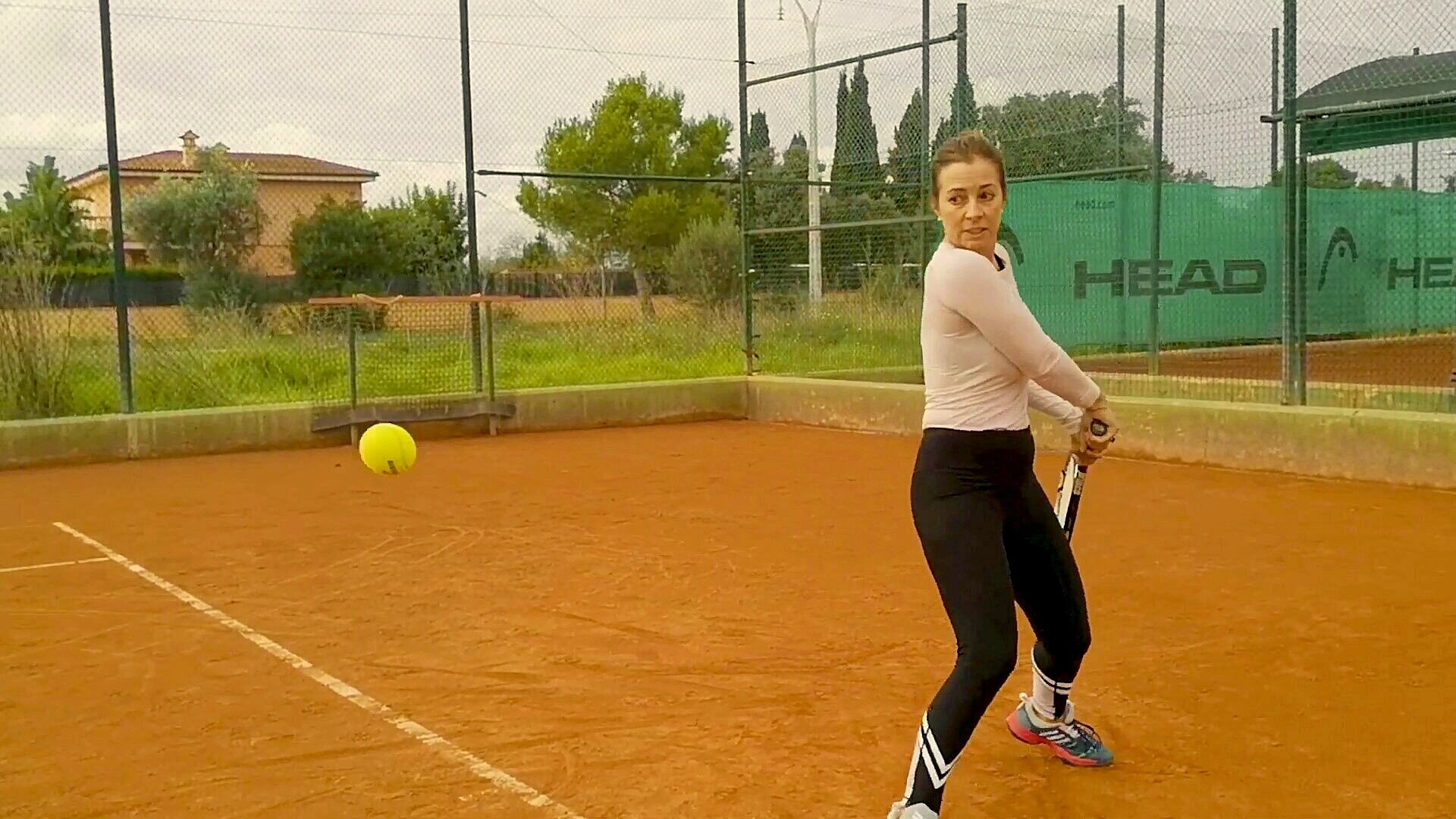Beginner Backhand: Why 2 hands are better than 1
Beginner Backhand: Use 2 hands for strength, momentum and deep balls
A lot of beginner players ask me during an adult camp 2 questions when it's time to learn the backhand. Why is a two-handed backhand better than 1 hand. And which grip do I use? The backhand seems to throw people off when it’s time to turn away from the forehand. But you should know, the backhand may become your more intuitive, easier shot - it was mine. This is your next step before you’re out there, rallying balls. Once you’re rallying balls, you’re officially playing tennis! Like anything worth it, tennis isn’t something to be learned but experienced, so be sure to get out on court and feel a ball on the strings. That’s the only way to learn this game. Especially the 2-hand backhand!
A beginner adult 2-hand backhand uses 2 hands on the racket handle, a continental grip, complete body turn and full extension off and around your body through contact to the other side of your body. The backhand mirrors the forehand. But is often an easier more natural shot that helps add power for beginners.
Beginner 2-Handed Backhand: 2-hander’s for high balls, control & power
This may wind up being your preferred ground-stroke in tennis when you’re getting started. Everything about this shot was more intuitive for me when I played as a kid. While everyone had raging forehands and loved hitting them, I craved a backhand. A 2-handed backhand did so much work FOR me. I could get natural, deep, heavy balls into the other side of the court using a 2-hander over a 1 handed backhand.
The shoulder turn naturally turns the entire body. So once I got close to the ball, and it was time to set up the shot taking my racket back did all the hard work & that FULL turn was everything! It got my body dug into the ground, ready to strike.
And WOW! when I found the strike zone at waist height - the rest was history. The ball lifted, sailed like a bird across the net - deep into the court with ease & consistently!?? Well, maybe you’ll feel the same.
Another thing! As a beginner you’re hitting against other beginners. Everyone is initially hearing, “CLEAR THE NET - NO BALLS IN THE NET”.
So when you start having rallies, you’re going to experience a lot of high balls coming at you.
A two-handed backhand handles high balls better than a one hander.
You can do one of 2 things.
1.) Back yourself up deeper behind the baseline & let the ball bounce & drop into your strike zone around waist height.
or
2.) Take the ball at shoulder height and swipe straight up & out - fully extending to the other shoulder!
You heard me right! Take a high ball at your left shoulder height & finish around at the other shoulder. You’ll naturally add topspin to the ball and see it sail HIGH into the air.
The cool part? Your wonky ball coming at your opponent is nerve racking - psychologically they’re rattled. When a ball has topspin on it, it bounces & kicks out in ways that throw your opponent off balance. And as you learned in the forehand ground stroke - your balance is a key to your power on court as a beginner player.
Pro tip: 💫
Adult tennis camps by playing level & travel destination for Summer 2023 check here.
Beginner Backhand: How to hit it …
switching tennis grips between forehand and backhand tennis strokes
Beginner Backhand Grip: The continental grip 2-handed backhand
Start in your ready position behind the baseline. Racket perched in front of you. As always.
If you’re practicing this shot in a lesson or a drill, hold the racket in your continental grip.
But if you’re in a rally unsure of which direction the ball was coming, hold your forehand eastern grip.
If you’re alert on court and see the the ball coming to your backhand, you’ll need to switch grips.
This oh so subtle action & ability will move you towards the intermediate level sooner than you know. Making your grip change during a rally between a forehand to backhand and vise versa. Now you’re starting to play tennis.
You also have plenty of time to make a grip change so don’t worry! Eventually you’ll switch grips instinctually, subconsciously. But give it a 1000 balls, pleassse!
For now you only need to know that there is something called a grip change from a forehand (eastern) to backhand (continental) grip.
Your 2-handed backhand mirrors the forehand stroke on the other side of your body with a couple nuances.
Beginner Backhand: The shoulder turn
For right handed players (lefties go the other way) make a full shoulder & hip turn to your left setting up for the ball. See my body turn in the video above.
Position your front right foot diagonal towards the net post on your side of the net. That diagonal stance lets your body turn freely into the ball heading towards your strike zone. As you swing and your body unwinds itself through the shot, you’ve just naturally applied power.
Without your front foot slightly open (for right handed players) you’d feel entirely awkward & restrained. (And don’t laugh at my design image). 🤫
If your front right foot were to cross and line up alongside the baseline … you would have zero freedom to turn and move. You’d literally lose power.
2 Hand Backhand Contact Point
In the image above, Jofre Porta above opens his front foot . See how it’s slightly open? It allows him to contact and turn into the ball and court, easier.
His contact point is at waist height but it ‘s closer to him than on the forehand. That’s because there’s 2 hands on the racket and he has less leverage to reach. But by having 2 hands on the racket he has more control, lift and strength.
On the backhand you don’t have the help of a free non-dominant hand to line up your contact point like the forehand. The experience & sensation of the shot will naturally find your best contact point closer to you. Otherwise you’d feel like you could fall, forwards. That’s not the feeling or shot you want.
“The most valuable lessons in life can’t be taught, they must be experienced.”
I should mention that your left hand is doing a lot of work on this shot. Consider it the brains of the shot. The right arm here is the braun (strength). Your left is guiding the ball on contact to where it is you want the ball to go. This hand is also adding spin to the ball that you may be unaware you’re adding. Nice little bonus for ya!
The Beginner Backhand Double Hander: Footwork
Keep the footwork as simple as possible. Get to the ball. Make those tiny adjusting steps to get you as close as possible to it. Turn sideways and step into the ball.
Forget hitting this shot now or in the near future in an open stance. It’s toooo hard to balance. Some pros use this, yes! But you don’t need a Herculean challenge as a beginner. I’ve yet to see many level high recreational adults or juniors pull it off.
How to shape the beginner 2-handed backhand
As you take your racket back shape it in that small inverted “c” you made on your forehand here.
That loops and drops the racket head nicely (it looks good too) for the incoming ball. Then swing from under - up & away from your body and through the ball. Just like we did on the forehand side!
At the end of the shot as your finishing, if your back left foot wants to step through naturally for better balance - great, let it come ! It’s made your recovery step, getting you back to your ready position easier and natural.
If it didn’t come through from the velocity of your swing - don’t worry about it. Sometimes it will sometimes it won’t.
The 2 Hand Backhand Finish: Focus on the finish
#RhondaCosta
As you do hit the ball, fully extend your body through the shot.
If you let your front right elbow bend or break to early, your finish will cave on to your chest. And the ball will go nowhere. Look at me in the photo above. When I finish the shot, the racket and my elbows are high, and away from my chest. Emphasize finishing here too.
Long fluid strokes always produce gorgeous deep heavy balls that are uncomfortable for your opponent to return. I mean it!
Rotates as far as your body allows - swing for the fences when you’re starting out. That’ll give you the feeling you want to experience.
Got it?! No COLLAPSING the right elbow too soon and landing on your chest. The ball can go nowhere.
Where Should You Hit it?
First of course, hit it over the net and inside the lines.
When you feel the ball better and your ready for the next challenge - hit crosscourt.
Hitting cross-court gives you the most range, angle and security.
Then practice down the line. Which is your lowest % shot and hardest to make because you’ll be hitting over the highest part of the net.
Once you get the backhand down - you’ll need to start practicing changing grips between the forehand and backhand so you can rally a ball and really start to make a name for yourself! ✨
Peak at the video above to see how to make a grip change between shots.
To better understand what grips you’ll need as a beginner read this.
For the ideal contact position on your forehand this post will help.
For a deeper dive into the beginner forehand this one will deliver.
And to learn the foundations on all core tennis strokes for beginners click here.
Enjoy the 2 hand backhand and know understand you’re now moving closer to your first real rally.
With love from Mallorca~




